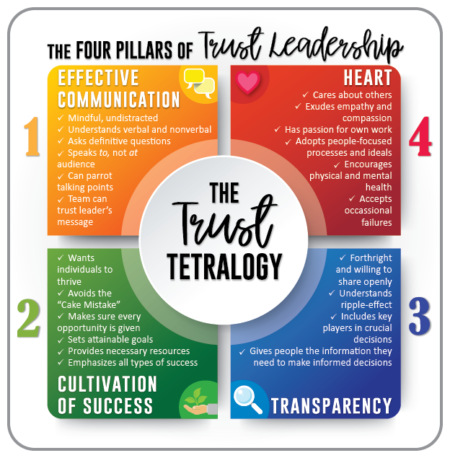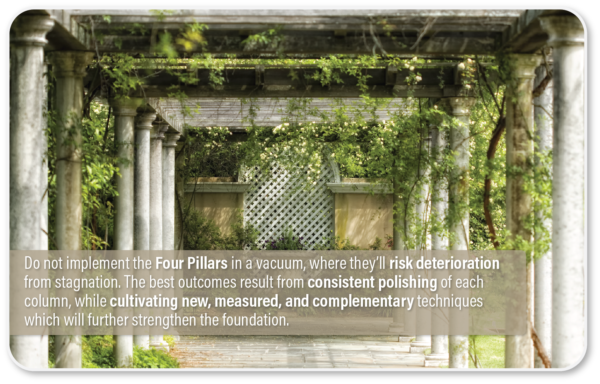The Trust Tetralogy: Four Pillars of Trust Leadership by Alice P. Stapleton, MSL | Guest Blogger
The Foundation of Trust Leadership
In part one of our 5-part series on trust leadership, Defining Trust Leadership for Today’s Workplace, it was established that a trustworthy leader is the foundation of an effective team. If you have any experience supervising, mentoring, or directly affecting the success of a person, group, project, or program, you know this to be true. You may manage a team of 25 full-time employees. Your work team may not report to you, while still looking to your expertise and work ethic for guidance. Perhaps you coach your daughter’s little league softball team, or maybe you volunteer at the local shelter. You may plan events for the PTA, or you make your community a better place by checking in on your elderly or ailing neighbors. Of course, for the sake of argument, this blog series is strongly targeted at working world professionals – but we are all, in fact, leaders.
The point: Almost everyone interacts with others, even if that interaction is brief or only occasional. And because you must

Leaders that give and encourage trust, are committed to four ideals. The “pillars” are habits, behaviors, and attitudes that inspire honesty, candor, and sincerity in giving and receiving.
manage your approach to others, you are a leader – whether you want to be or not. The choice you get to make is the kind of leader you want to be.
The Whole > Its Parts
Trust Leadership is accurately reflected in Aristotle’s observation that “the whole is greater than the sum of its parts.” The very best leaders know that outcomes are a direct reflection of the trust they foster through their actions and attitudes – of which there are many. If each of these tangible behaviors were numbered and listed on notebook paper, they would require multiple volumes. In the workplace, a manager’s habits, conduct, and style blend together to form what is or is not trust leadership.
The Trust Tetralogy & The Four Pillars
Of course, we want to focus on those habits and styles that produce great results, and which can be tied to the honest and trusted leaders we admire. These actions, displayed almost subconsciously by the world’s great leaders, are not learned overnight, but are instead honed mindfully over time. And most often, these actions (each and every one) are added together to create one of four pillars – pillars that act as the support system to the overall practice of trust leadership. We call this 4-pillar support system, The Trust Tetralogy.
Pillar #1 – Effective Communication
The first pillar of The Trust Tetralogy, effective communication, is arguably, the most important. We know communication is the techniques and processes used to convey and exchange information. We are taught to communicate from the time we are young. However, the key word in pillar #1 isn’t “communication.” It is instead, “effective.”
What makes communication effective? Effective communication begins with listening; being mindful of what is being conveyed to you – both verbally and non-verbally. Attentiveness to the other person’s tone, mannerisms, and word choices is crucial to your understanding of the message they are trying to send. The best listeners keenly focus, do not allow their minds to wander, and are able to repeat back what has been said, and even, what hasn’t. And when an effective communicator is unsure of exactly what information they’ve received, s/he asks definitive questions to assist in successfully gleaning the communicator’s intended ideas.
In conveying information, effective communicators speak to their audience as opposed to at them. Unless it is Sunday, most people do not like to be lectured. Leaders who use words, tone, and body language that is relevant and audience-appropriate are more successful than those who stray from the intended point, are imprecise, or appear preachy when delivering their message.
Trust leaders converse, both to gain the knowledge and opinions of others, and to ensure that their audience has received the message they are trying to send. If your team or those around you can trust that they understand your message – and that you mean what you say – you’ll be well on your way to becoming a trust leader.
Pillar #2 – Cultivation of Success
Leaders who understand the importance of trust to their own success, are strongly committed to the cultivation of success in others. A culture of trust in only possible when those in positions of authority provide the resources and support necessary for each member of a team to favorably contribute to a common goal, and thereby realize personal success and growth.
Let’s imagine you ask someone to bake a cake. You provide him with the recipe, instructions, and supplies he needs. However, you replace the sugar with salt. The result may still a cake, but it will taste terrible. It will taste terrible regardless of the scenario that led to the substitution. We call this the “cake mistake.”
You may have switched the sugar and salt on purpose. It may have been an accident. The baker may or may not have known about the switch. He may have thought you knew, and so did not question your directions. Whatever the reason, the cake is inedible.
And like the “cake mistake,” leadership that is doled out but either incomplete, misunderstood, or irrelevant might, on the outside, appear to be real leadership, but is actually only perfect in its inadequacy.
Setting people up failure may not be intentional, but it is always detrimental. You can avoid your own “cake mistake” by adopting an unyielding commitment to giving every team member, client, customer, or other constituent, every single opportunity to accomplish those goals that you have set together. Be attentive, ask questions, and get to know the individuals you are leading. Their accomplishments are your accomplishments. Give them the resources they need to do the job that you both want done.
Pillar #3 – Transparency
In the workplace, there will always be concerns that arise which are not the business of the team at large. Transparency does not mean being an open book about personal issues or beliefs. It is not about airing your frustrations at your own boss or being allowed to display unsavory behavior. Transparency refers to a leader’s willingness to be forthright with her team, even when she is disappointed, worried, or in need of help.

These techniques will become stronger over time, and will allow you to consider new habits for greater trust in your leadership role.
Your team members and your clients should be given the information they need to make informed decisions. A guest who travels to a wedding and pays for accommodations in a hotel selected by the bride – only to discover that there is a loud, obstructive construction project underway outside her guestroom door – will likely feel cheated, and perhaps even resentful. If, as the sales rep, you were aware of this potential problem, but did nothing to inform the bride in advance – you were not transparent, but thinking of the bottom line before that of your customer’s special day. And in turn, you’ve almost certainly lost the bride’s future business, as well as her guests – and any person she or they may have encouraged to stay at your establishment.
Lack of transparency can lead to a ripple-effect of devastating results. So, be honest about your intentions, your expectations, and your needs. And allow other to also be transparent with you.
Pillar #4 – Heart
If you are not interested in the well-being and happiness of others, you have no business working in a leadership role. Leadership requires heart. Both a heart for the work, and a heart for others.
Kindergarten teachers should enjoy working with children. Hotel owners should appreciate comfort and have an affinity for travel. Librarians should enjoy reading. The old adage, “Do what you love,” isn’t always possible – but it is possible to find something you love in the job you have – even if it isn’t the job you want to be doing forever.
How do you put your heart into your role as a leader? First, find the niche in your work that most contributes to your feeling of accomplishment – and do that thing with vigor. It’s unlikely you will be able to do that thing or collection of things all day, every day, but it will be an area of your work at which you excel, and one that you can look forward to doing when the opportunity arises. When others witness you working with passion, they will follow.
As for those leading others – in the workplace or elsewhere – be kind, genuine, and fair. Of course boundaries are essential to a productive business, but trust cannot thrive in the absence of empathy. Adoption of a set of people-focused ideals that revolve around your team’s physical and mental health (and those elements of life that contribute to them), will almost certainly result in loyalty, sustainability, and productivity.
Pillars: Less Like Columns, More Like Trees
It is easy to think of the Four Pillars of the Trust Tetralogy as tall Greek-like structures – sturdy and strong, but also unwavering and inflexible. But, they are only as sturdy as a leader makes them. The more consistent a leader is in her implementation of the four pillars, the more trust will grow and thrive.
But, if you attempt to lead using the Four Pillars in a vacuum, without allowing them to blossom into branches of new and effective habits and techniques that will contribute to an even stronger foundation of trust, your leadership skills will suffer from stagnation and stunted growth.
Therefore, use the Four Pillars to plant the seeds of a great tree that will grow upward, downward, and outward – allowing your leadership skills to flourish.
Want to learn more about trustworthy leadership in a client-centric environment? Contact DSS today. We want to work with your team!
